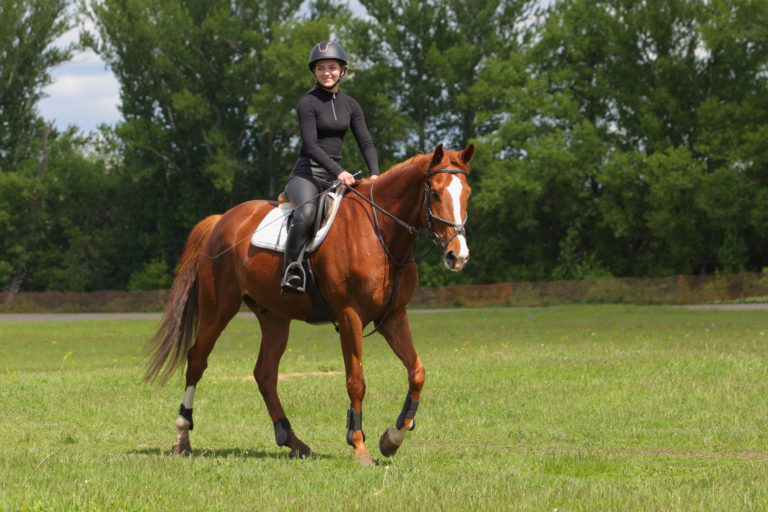
Getting started
Here we outline a few of the key elements you need to include in training of your senior horse.
However, it goes without saying that you should not start any training programme for any horse without first consulting with your coach, and perhaps also in the case of a senior horse, your vet.

The wonders of walk
One only needs to read the books of the great trainers to realise that they recognised the importance of the walk even in young horses. Similarly, it is no coincidence that experienced horse riders often encourage their pupils to walk their horse for the first and last kilometre of the ride, regardless of the horse’s age. This practice makes sense, because a warm-up period of 10 minutes of walking will increase the delivery of blood and oxygen to the muscles reducing the risk of injury or strain. Walking the last 10 minutes of ride similarly gives a horse the chance to cool down and to remove the toxic lactic acid that will have built up in the muscles during the training session. This reduces the stiffness a horse experiences on the day after training. If the walk is as important as the great horse trainers seem to think even in young horses, then it makes complete sense that walk is the right place to start when bringing your senior back into work.
Conditioning of the older horse should begin with riding the horse every other day at a walk for increasingly lengthy rides, starting with a 15 minute ride, then a 20 minute ride, then a half hour ride, then a 45 minute ride, then an hour ride and so on.
Many of us become impatient with the walk and rush to do other exercises and gaits. However, it is absolutely vital, particularly with senior horses, that we never underestimate the value of time spent walking. Walking improves the condition of your horse by slowly stimulating the ligaments, tendons and muscles to accept an increased load. For example, with a rider on board, walking loads a horse’s fetlock joint with 2.5 times its weight. The stifle and hip are loaded with 1.5 times the horse’s weight. This additional loading allows the horse to adapt at a reasonable rate and reduces the risk of injury. Moving into higher gaits too quickly can overload joints and soft tissues resulting in injury that will delay your progress far more, than just taking the time you need to in the walk.
Walking also increases the heart rate. Depending on the weather – and the current condition of your horse – walking might increase his heart rate from an at rest pulse rate of around 30 beats per minute (bpm) to as much as 90bpm. This means that even though your horse may not be sweating at the end of the session, his cardio fitness has certainly improved. Working on this gradually, particularly in an older horse is vital for their wellbeing. You wouldn’t ask your granny to suddenly do a 100m sprint – so don’t ask your horse to do the same!

Another valuable exercise in the walk is to periodically allow your horse to walk on a long-rein. Walking in this way with loose reins, encourages him to stretch his neck and back and avoids muscles becoming tight and contracted. This helps to reduce tension and keeps muscles in the older horse elastic and supple.
Next steps
Start as described above with walking on the flat for increasing periods of time. Once your horse can comfortably walk on the flat for around an hour you can gradually build the training up to include more hills and inclines. Hills, whether being ascended or descended, are harder on the muscles, soft tissues and joints but once your horse can comfortably cope with walking for an hour on the flat he will be ready for the extra loading.

Another option at this point, is to introduce poles for your horse to walk over on the flat. This is great for helping your horse to strengthen his core and general musculature and will similarly increase the load on his joints, but in a gradual fashion.
After a few weeks of just walking like this, it is usually time to introduce short intervals of trotting interspersed with walking. For at least the first month, however, at least two-thirds of your time should be spent walking and a maximum of one-third spent trotting. Trotting must also be done only on the flat, at least to begin with.
For many horses, both young and old, an adequate degree of condition can be obtained using only this Long Slow Distance Training (LSDT). Slowly increasing the distance and speed allows condition to be improved gradually without overloading the horse. You must never make a sudden increase of both speed or distance in a training session. One or the other should be increased when the horse is ready for the next step in the programme, but both must never be increased together.
If you stick to this rough schedule for the first six weeks, you then be ready in most instances to start to introduce the canter for brief periods.
After this you will really need specialist advice from your coach to tailor the programme to your specific discipline. As a rule of thumb, however, if your coach would normally take a month to get to a particular point with a young horse, in a senior horse you should allow at least two months to reach the same point.
NOTE: Adding carrot stretches into your routine with your senior horse can also be hugely helpful in suppling them up before your session and helping to stretch them out after your session.

